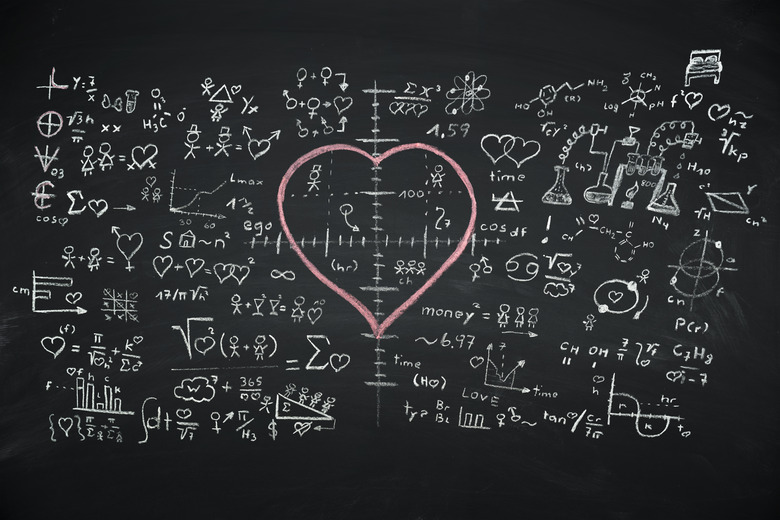Which One Is The One? Math Has The Answer
You'd be forgiven for thinking that math is probably the least romantic thing in existence. Something about the coldness and unflinching impartiality of calculations gives off the impression that it's completely antithetical to romance. But, like it or not, math has a way of inserting itself into pretty much anything we choose to do in this universe, and dating is no exception.
The problem is simple: If you can accept that settling down with the first person you ever date isn't a great idea, and that if you wait too long you might reject "the one" for you, then who should you settle down with? While you're probably not thinking about that at this point in your life, you'll probably want to know eventually, right?
As Hannah Fry points out in her book The Mathematics of Love, this is an example of "optimal stopping theory," and math actually does have the answer.
The Problem: Which One is the One?
The Problem: Which One is the One?
The optimal stopping problem has been cast in many ways before, such as the "secretary problem" describing how many candidates you should interview before choosing one to hire, but the Valentine's-friendly (ish) version is when you should commit to a specific partner out of the possible options. If you choose one to settle down with too soon, Mr. or Mrs. Right could have been waiting just around the corner, and if you wait too long, they might have been snapped up by somebody else already.
Striking the right balance between these isn't easy, and that's at the heart of this problem. What's the best strategy? How long should you date before you decide to stick with the next good option?
Solving the Optimal Stopping Problem
Solving the Optimal Stopping Problem
Before talking about the solution, it's important to remember that there will always be an element of chance involved here. Even if you follow the mathematicians' recommendations perfectly, we're only dealing with probabilities, and so there's no way of knowing if it will actually work in any specific case – just like you know that a coin flip is 50/50 but you can't reliably predict any one flip.
With this caveat in mind, mathematicians have found the magic number: 1/e, or more intuitively, about 37%. The best strategy, according to the calculations, is to date and reject the first 37% of options, and then go with the next person who is better than anyone you've dated before. This maximizes your chance of sticking with the best person in your lineup of potential partners.
However, this presents a couple of issues right away. First, and most importantly, nobody really knows how many people they will date over a lifetime, so it's hard to know the specific number to take the 37% from. The best idea is to either estimate or to base it on time – if you're 20 and intend to have found the right person by the time you're 30, date until you're around 24 (just before then if you want to be very accurate) and then go with the next person who's better than all your previous partners. The second problem is how you rate each partner, but you'll just have to go with your gut on that one!
Understanding the Love Math
Understanding the Love Math
You can understand the math underlying this estimate by looking at a simple case with three possibilities, ranked from 1 to 3, with three being the best. These are the possible orderings:
1 2 3
1 3 2
2 1 3
2 3 1
3 1 2
3 2 1
If you chose the first partner, you'd get the best one 2 out of 6 times, and if you rejected the first two, you'd have the same odds of getting the best one. However, using the strategy, you'd reject the first one, and then choose the next one you encounter with a higher score. This would give you the best option in the second, third and fourth rows – an improvement to 3 out of 6 in terms of your odds, and the overall result generalizes to bigger samples, too.
Alternate Versions
Alternate Versions
This isn't the definitive answer, though, because the problem itself has a few assumptions baked into it. For example, mathematician Matt Parker points out that somebody who is nearly the best is still a pretty good outcome – you don't have to get the very best partner. In this case, out of a lifetime number of partners n, you should date and reject the first √n possibilities, a little lower than in the previous version.
Finally, Minoru Sakaguchi came up with an alternate version where your main preference is the best partner, but the next-best option for you is remaining single. In this case, you shouldn't consider settling down until you've been through about 61% of your potential matches.
However, arguably the most important alternate version is the real life version. You never know who will be the best person for you, and you don't want to pass up on somebody great just because they were in the first 37% of dates – so really, there is a reason the advice is "follow your heart" and not "break the problem down into mathematical terms and stick steadfastly to the optimal strategy."
References
Cite This Article
MLA
Johnson, Lee. "Which One Is The One? Math Has The Answer" sciencing.com, https://www.sciencing.com/mathematics-of-love-13724720/. 31 March 2020.
APA
Johnson, Lee. (2020, March 31). Which One Is The One? Math Has The Answer. sciencing.com. Retrieved from https://www.sciencing.com/mathematics-of-love-13724720/
Chicago
Johnson, Lee. Which One Is The One? Math Has The Answer last modified August 30, 2022. https://www.sciencing.com/mathematics-of-love-13724720/
